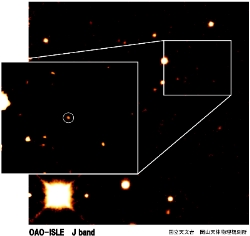Detection of the light from the most distant known object
| Science

Okayama 188 cm telescope successed to catch the light from the most distant known object in the Universe (13 billion light years away from the solar system). The light came from the phenomenon known as a Gamma ray burst (GRB) which is believed to be associated with the supernova explosion at the end of a massive star that collapse into a black hole.
The event was detected on April 23, 2009 by NASA's Swift satellite which aims to catch GRBs, particularly very distant bursts. The 10 seconds burst was located on the constellation of Leo and was named as GRB 090423. An immediate alert was distributed to ground-based telescopes all over the world. Astronomers are keen to observe the aftergrow, because they provide us the most information on their distance and the nature of the exploded stars. GRBs last less than a second to several minutes and afterglows fade out so fast, the astronomers must observe them very quickly.
A NAOJ team lead by Prof. Yoshida reported detection of the light at the very position of the GRB 090423 using an intrared camera installed on Okayama 188cm telescope (ISLE). The infrared observation by the VLT of the European Southern Observatory established the distance of a redshift 8.2 (about 13 billion light years away) to the GRB. The source detected by the Okayama telescope was the light come from the most distant known object.
"I had not expected to detect such a distant object by using the 188cm telescope. We were very lucky, because we happened to mount the infrared camera when we heard the detection of GRB090423.", Prof. Yoshida says. "We also led an effort to obtain visible images of the aftergrow, but we could not catch the light shorter than infrared."
Because of the expansion of the Universe, an ultraviolet light is shifted into the visible region. But beyond a certain distance, we cannot see the visible light due to ultraviolet-absorbing hydrogen gas grows thicker at earlier times. The fact of detection at the infrared region but non-detection at the visible suggested the very distanct event.
Prof. Yoshida talked, "We cannot predict when and where GRBs happen. We have to develop a world-wide network to quick follow-up observations."
Link
More info: OAO web page (Japanese only)